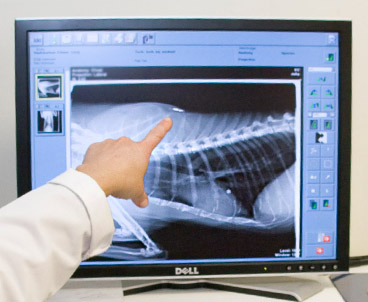Diagnostic Services
 Digital Radiographs
Digital Radiographs
Radiographs, or X-rays, are one of the most common, useful diagnostic tools in medicine. The veterinary team at South Fork Animal Hospital uses X-rays to examine your pet's bones, lungs, heart, abdomen, oral cavity and other areas and for diagnosing and monitoring many medical and surgical conditions.
As part of our commitment to provide you with the best medical care for your pet, South Fork Animal Hospital has invested in a state-of-the-art digital X-ray machine. There are many important advantages to digital X-rays:
- They can be immediately viewed on a computer monitor.
- The clear, detailed images can be manipulated to get a better view of your pet's bones and internal organs, leading to a faster, more accurate diagnosis.
- They take less time to process, which means less time for your pet on the X-ray table (and less stress), and less waiting time for you.
- No harsh chemicals are needed to develop the images, reducing potential harm to our staff and the environment.
If a second opinion is necessary, digital X-rays can be sent by email to a board-certified veterinary radiologist.
Ultrasound
Ultrasound is a painless, safe, non-invasive procedure that produces a real-time moving picture of your pet's organs, allowing your veterinarian to visualize objects that cannot be detected by X-rays alone. It is one of the many ways we strive to give you peace of mind when it comes to your pet's health.
Our veterinarians use ultrasounds to assess the shape, size, tissue density, internal structure and position of your pet's abdominal organs, assess cardiac health (also called an echocardiogram), and diagnose pregnancy. It can also be used to identify masses or tumors and as a guide during surgical biopsies.
The ultrasound procedure takes between 30 to 60 minutes to perform and, unless it is being used during a surgical biopsy, does not typically require sedation. A diagnosis based on what we see is usually available immediately, which means we can also provide you with treatment options at the time of your appointment and minimize your worry and stress.
Endoscopy
Endoscopy is a minimally invasive diagnostic procedure commonly used to evaluate the interior surfaces of your pet's organs through a small tube inserted into his or her body. An endoscopic examination can often accurately diagnose what is causing your pet's vomiting, diarrhea, weight loss, abdominal pain or swelling, loss of appetite or respiratory problems. It can also be used to collect biopsy samples and remove foreign objects, small polyps or tumors.
Although anesthesia is required to keep pets still during the endoscopic procedure, the recovery time is minimal. The benefits of endoscopy over exploratory surgery include no surgical incision, shortened anesthetic time, decreased inflammation, less stress and discomfort and an earlier return to normal function for your pet.
 Accurate diagnosis of your pet's symptoms begins with our ability to put together as complete and accurate a picture of what is going on inside your pet's body as possible. For that reason, endoscopy is recommended when routine blood and urine tests, radiographs and ultrasound do not give us the complete diagnostic picture.
Accurate diagnosis of your pet's symptoms begins with our ability to put together as complete and accurate a picture of what is going on inside your pet's body as possible. For that reason, endoscopy is recommended when routine blood and urine tests, radiographs and ultrasound do not give us the complete diagnostic picture.
Our In-House Medical And Diagnostic Laboratory
When performing routine wellness examinations or diagnosing an illness, what our veterinarians can't see is as important, if not more important, than what they can.
Because protecting your pet's health is our most important job, we have a complete in-house diagnostic laboratory that allows us to perform a wide range of tests on blood, urine, feces and biopsied tissue. Laboratory testing can provide information about your pet's overall systemic health as well as detect diseases and other conditions affecting your pet's health and well-being without the need for invasive, expensive procedures. Diagnostic laboratory testing is also completed prior to dental or surgical procedures that require general anesthesia.
Access to these test results in as little as 20 minutes plays an important role in the accurate diagnosis or assessment of your pet's health.